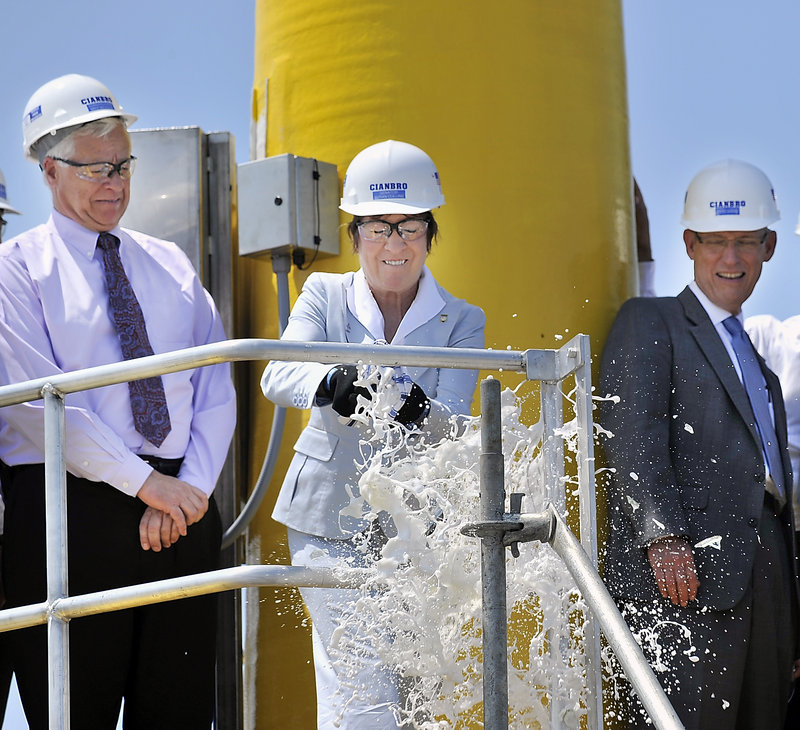BREWER – A crowd of hundreds applauded Friday as North America’s first floating offshore wind turbine was lowered into the Penobscot River.
On the site of what once was a large paper mill and now is used to make industrial modules, a Cianbro Corp. crane gently lowered a 90,000-pound prototype floating wind turbine, called VolturnUS, into the water.
Within two weeks, the unit will be towed 30 miles downriver to a mooring site off Dice Head in Castine, then plugged into Maine’s electricity grid with an undersea cable.
VolturnUS is 65 feet tall, one-eighth the scale of a full-size floating turbine. Its output will be 20 kilowatts, enough to power four average homes. If its technology is proven in the coming months, it could kick-start a local industry to support a full-size wind park, containing hundreds of turbines with rotor diameters larger than a football field floating 10 miles off the coast.
It was fitting that the new technology was launched on the banks of the Penobscot River. A century ago, Maine exploited a plentiful natural resource to build an economy, and the wood products manufactured here made this area the lumber capital of the world.
Hundreds of people stood in Friday’s broiling sun to watch the event, many pointing their smartphones to capture the moment. They clapped and cheered when the concrete base touched the river.
The historic parallels were clear to see.
Maine’s paper and lumber industry thrived in part from being in the backyard of the growing Northeast. Today, Maine is within transmission line reach of 55 million people who need affordable electricity.
The powerful, consistent winds that blow far off the coast have an energy potential of more than 100 nuclear power plants. If just a fraction of that energy can be tapped economically, offshore-wind supporters say, Maine can develop a new manufacturing and service industry.
“That is the opportunity,” said Peter Vigue, Cianbro’s president and a member of the University of Maine-led DeepCwind Consortium, which launched the wind turbine.
That theme was repeated several times in Friday’s ceremony.
Maine engineers are using concrete and advanced composites, instead of corrosion-prone and expensive steel, to fashion the world’s first floating wind turbine by using common materials in a novel way.
Maine business leaders are trying to use local innovation to their advantage in a bid to win a competition with multinational players.
And Maine university students are participating in a new technology and being part of something they will need to carry forward when today’s leaders move on.
Many who worked on the project were called to stand up during a long ceremony, coming to the front of the giant white tent wearing blue hard hats. They, along with workers from Cianbro, were recognized for their contributions to the project.
Maine’s congressional delegation, Gov. Paul LePage’s energy director and university officials also commented on the significance of the day.
When the speeches were over, several officials climbed a steel staircase to the base of the VolturnUS tower. There, U.S. Sen. Susan Collins, a strong supporter of the project, christened the turbine with the traditional bottle of champagne.
Officials also tried to sign their names on one side of the turbine’s base, but were foiled by the red marine paint, softened in the hot sun. Too much solar energy.
They had better luck on the unit’s shady side.
The months ahead will reveal whether VolturnUS, named for the Roman god of easterly winds, is stout enough to survive the Gulf of Maine’s fury and produce power as designed. By February, the consortium will know if it has won a multimillion-dollar federal grant to help fund a larger, commercial scale turbine.
But on Friday, it seemed, Maine was doing more than being buffeted by global events. It was taking aggressive steps to shape its future.
VolturnUS must beat out competitors for the government money. It is among seven projects nationally that won $4 million each in federal grants last year to help develop utility-scale offshore wind technologies. It’s vying for a follow-up award of as much as $50 million early next year for a project off Monhegan Island.
The $96 million pilot project would feature two, six-megawatt turbines and generate enough electricity for 6,000 homes in 2016.
VolturnUS also must have a contract to sell its power at rates that will support costs. Project officials are trying to negotiate an agreement with New England utilities in the range of 14 cents per kilowatt-hour.
The federal government wants commercial-scale projects that can generate power at 10 cents per kilowatt-hour in 2020, a rate that’s expected to be on par with natural gas and other sources.
The VolturnUS unit will remain in sheltered waters off Castine through June, then be towed to a site south of Monhegan Island for two months of tests in the open ocean.
Among the biggest questions to be answered is how the floating turbine will respond to motion created by wind and waves.
Tux Turkel can be contacted at 791-6462 or at:
tturkel@pressherald.com
Send questions/comments to the editors.






Comments are no longer available on this story